Control Statements Part 2 Logical Operators Chapter 5












































































































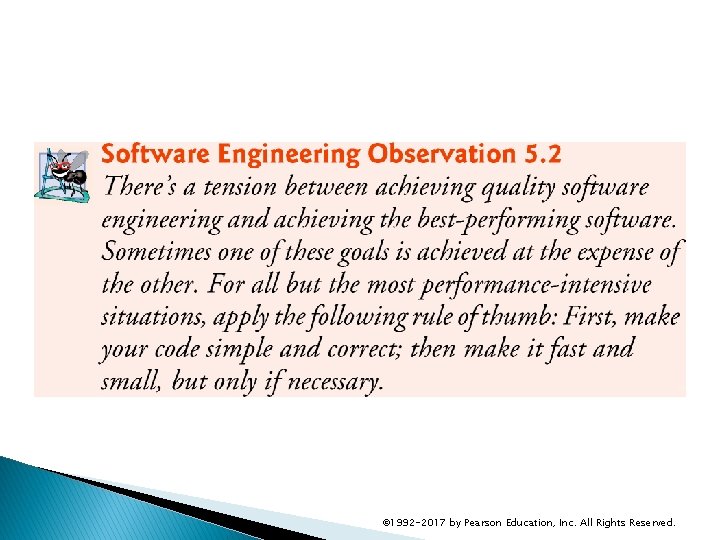
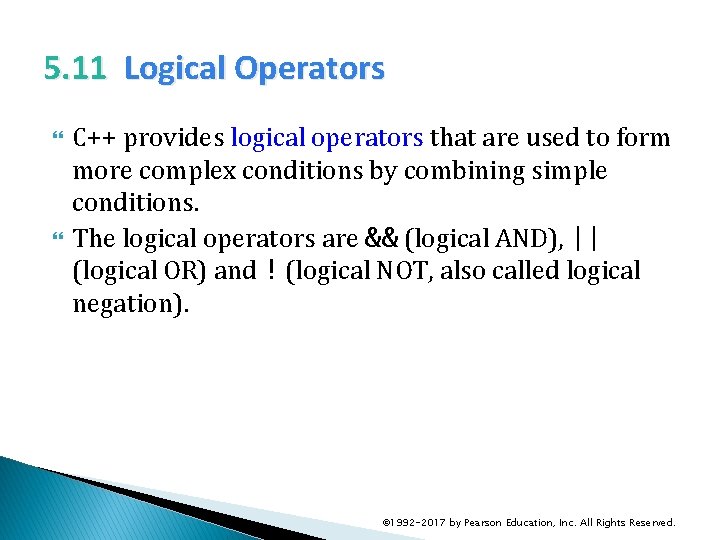


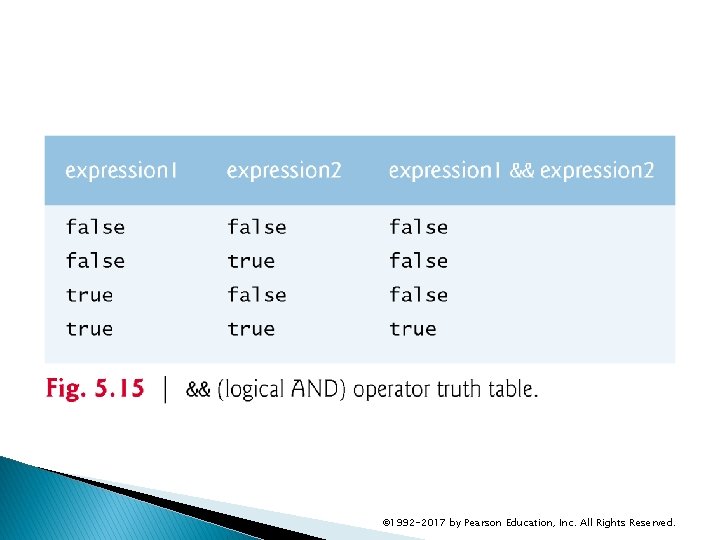
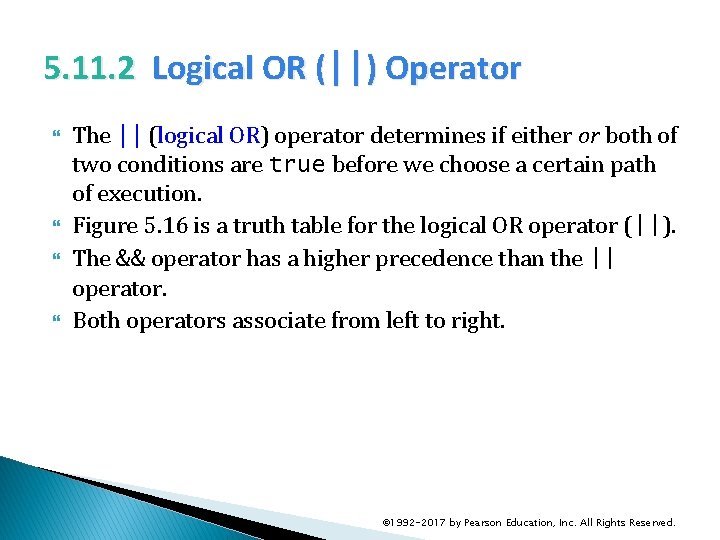
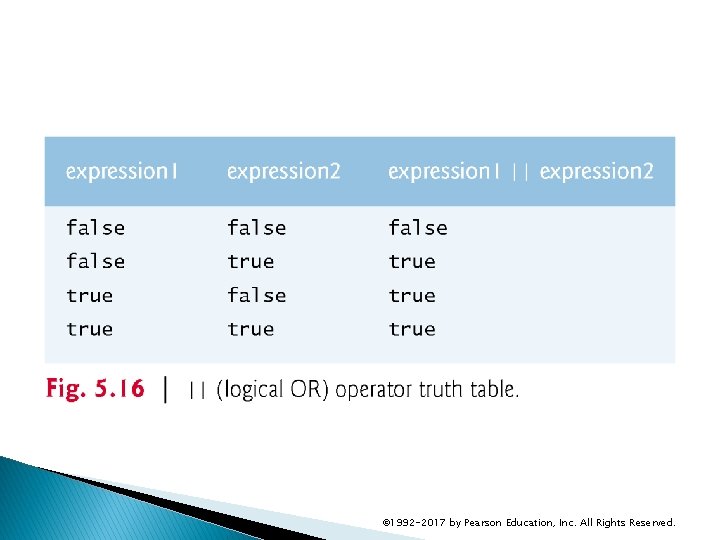

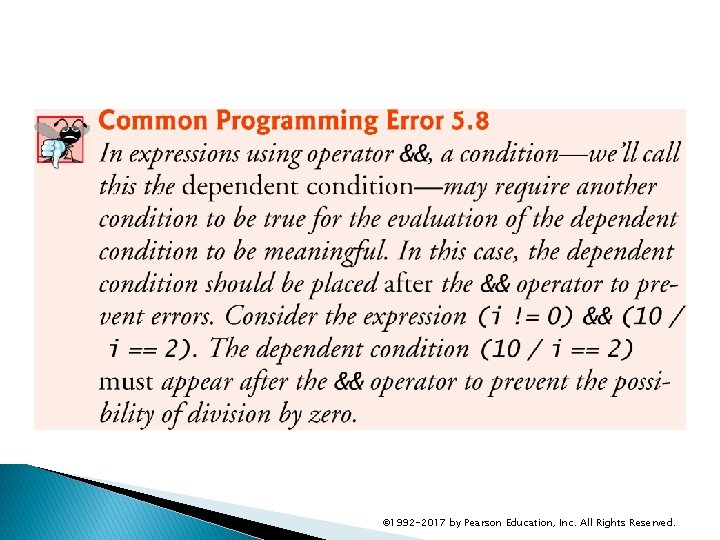
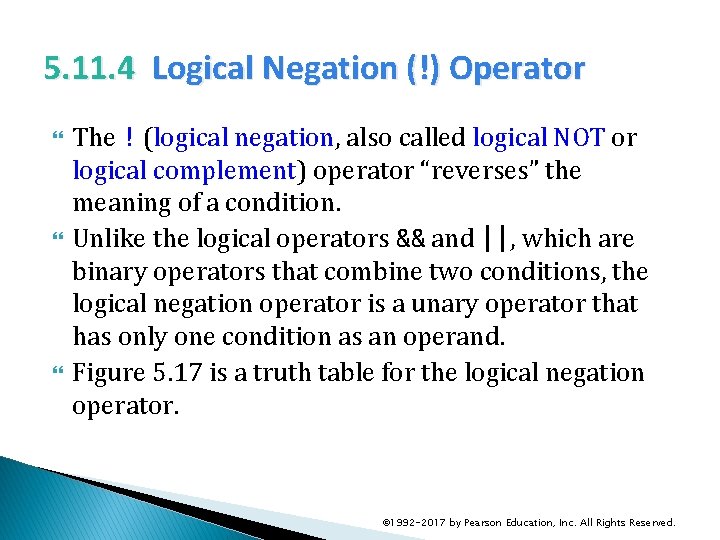
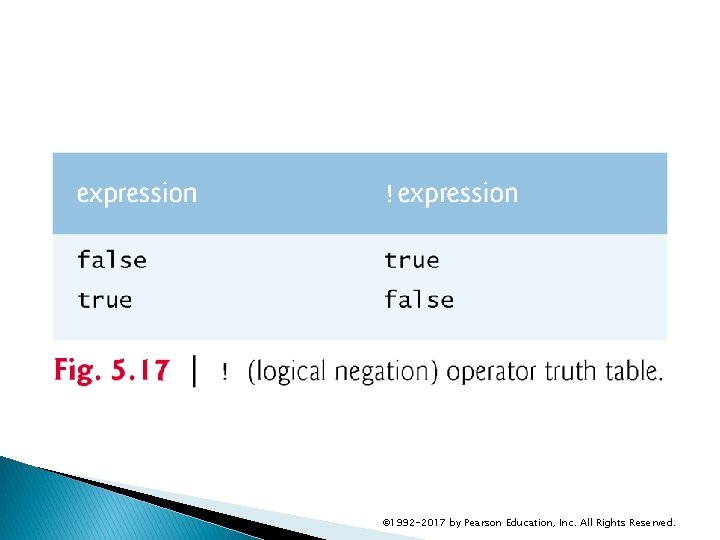
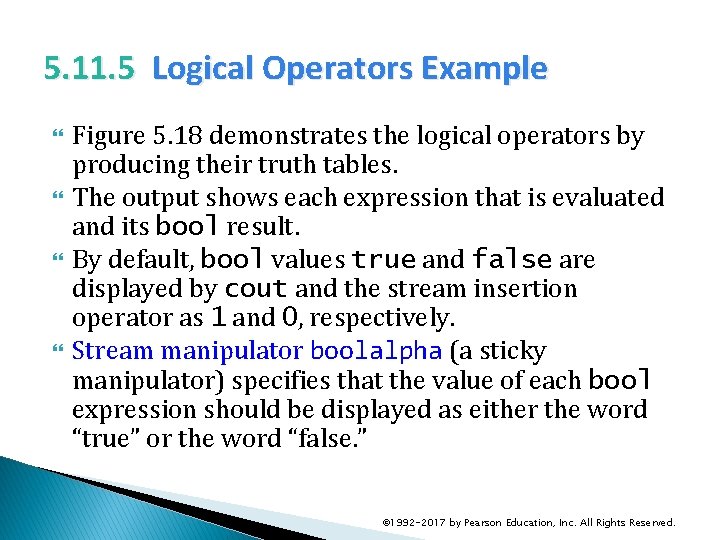
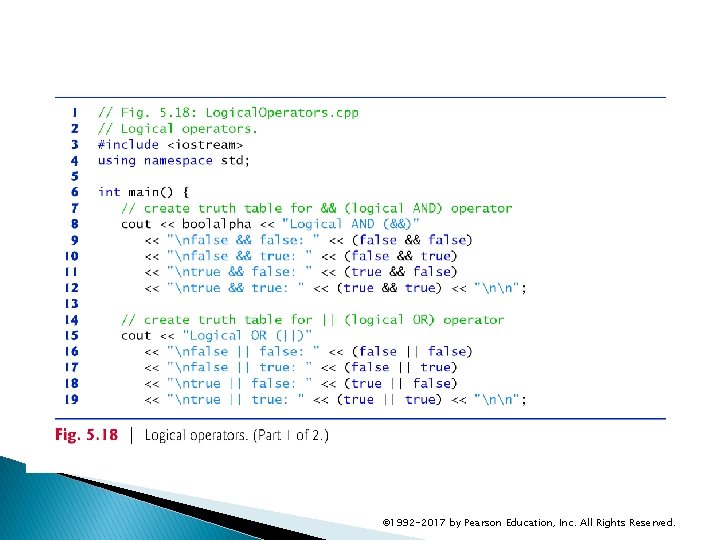
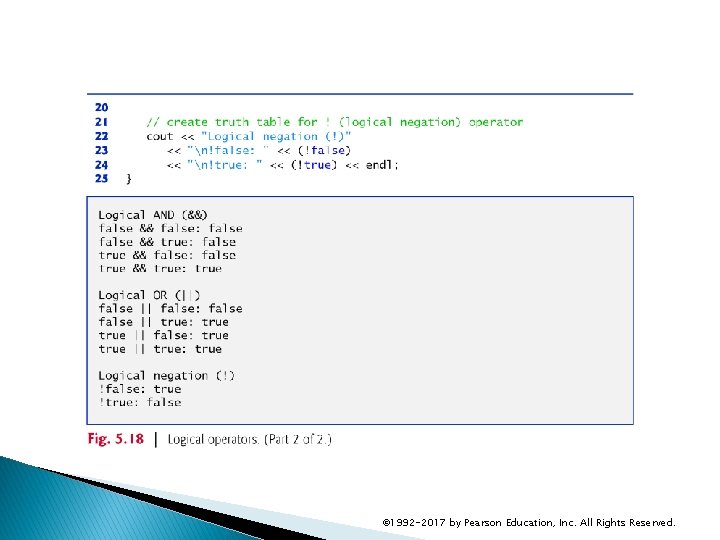
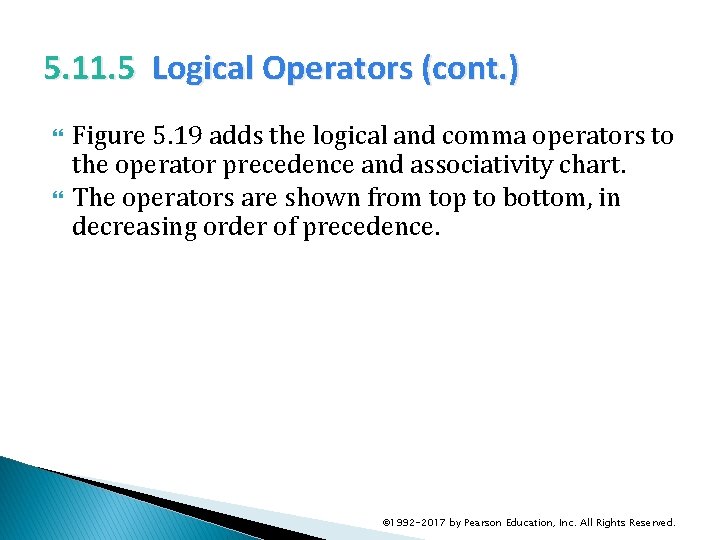

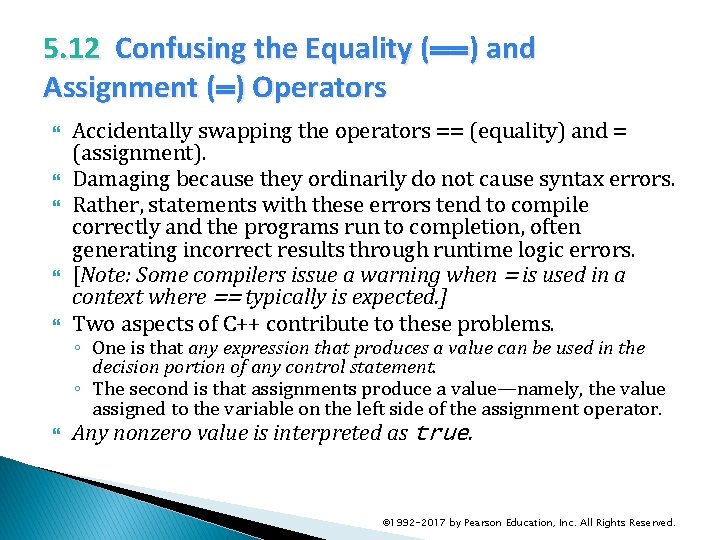
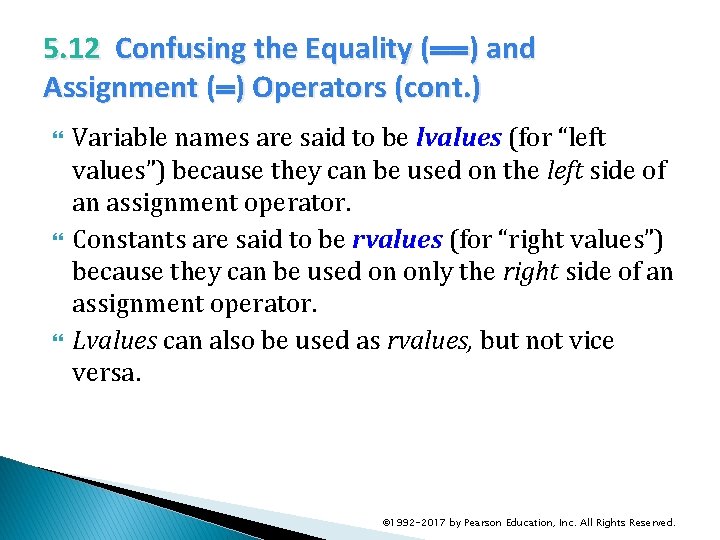

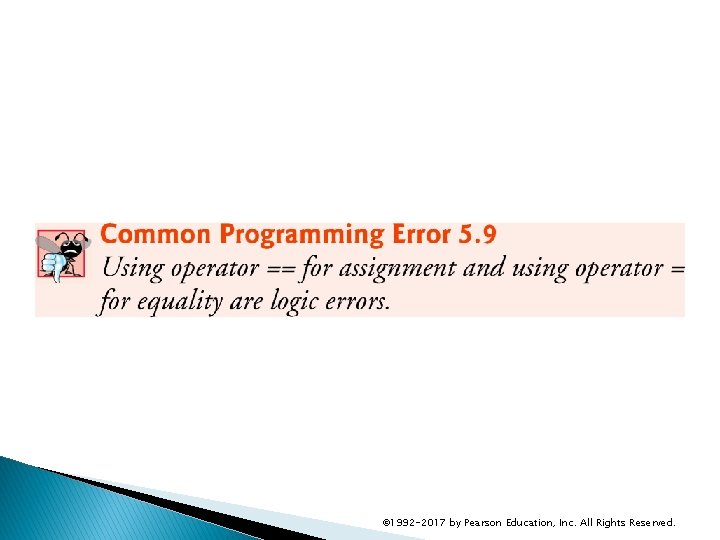





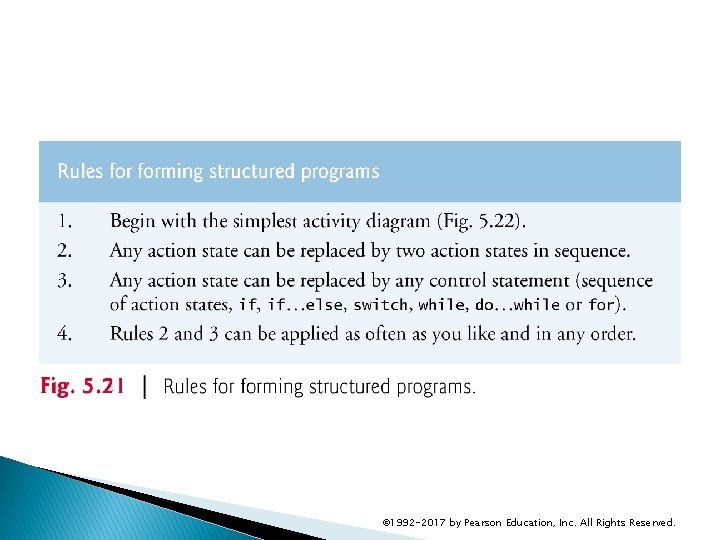

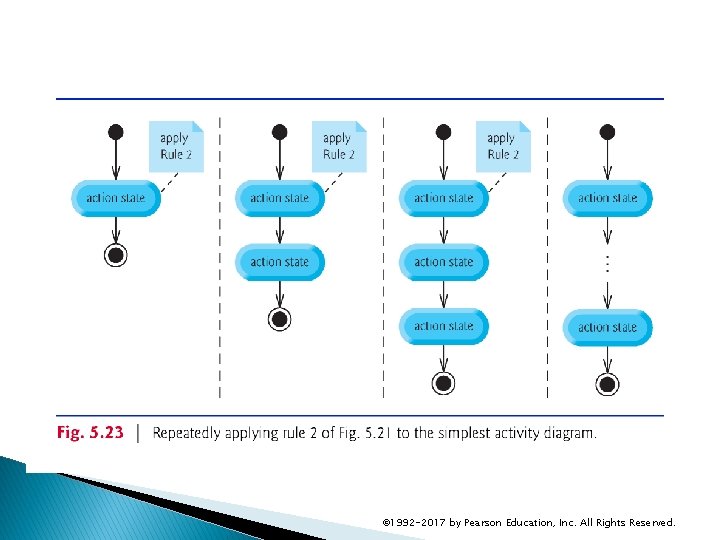
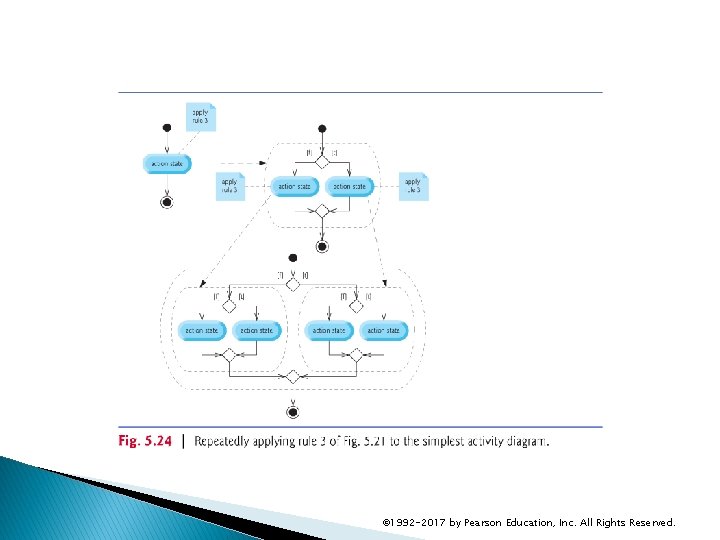

- Slides: 138

Control Statements: Part 2; Logical Operators Chapter 5 of C++ How to Program, 10/e © 1992 -2017 by Pearson Education, Inc. All Rights Reserved.

© 1992 -2017 by Pearson Education, Inc. All Rights Reserved.

© 1992 -2017 by Pearson Education, Inc. All Rights Reserved.

© 1992 -2017 by Pearson Education, Inc. All Rights Reserved.

5. 1 Introduction This chapter continues our presentation of structured-programming theory and principles. Demonstrates C++’s for, do…while and switch statements. We explore the essentials of counter-controlled iteration. We use compound-interest calculations to begin investigating the issues of processing monetary amounts, and we develop a new Dollar. Amount class that uses very large integers to precisely represent monetary amounts. © 1992 -2017 by Pearson Education, Inc. All Rights Reserved.

5. 1 Introduction We introduce the break and continue programcontrol statements. We discuss C++’s logical operators, which enable you to combine simple conditions in control statements. We summarize C++’s control statements and the proven problem-solving techniques presented in this chapter and Chapter 4. © 1992 -2017 by Pearson Education, Inc. All Rights Reserved.

5. 2 Essentials of Counter-Controlled Iteration Counter-controlled iteration requires ◦ a control variable (or loop counter) ◦ the control variable’s initial value ◦ the control variable’s increment that’s applied during each iteration of the loop ◦ the loop-continuation condition that determines if looping should continue. © 1992 -2017 by Pearson Education, Inc. All Rights Reserved.

5. 2 Essentials of Counter-Controlled Iteration The program in Fig. 5. 1 prints the numbers from 1 to 10. The declaration in line 8 names the control variable (counter), declares it to be an unsigned int, reserves space for it in memory and sets it to an initial value of 1. Declarations that require initialization are executable statements. In C++, it’s more precise to call a declaration that also reserves memory a definition. © 1992 -2017 by Pearson Education, Inc. All Rights Reserved.

© 1992 -2017 by Pearson Education, Inc. All Rights Reserved.

© 1992 -2017 by Pearson Education, Inc. All Rights Reserved.

5. 3 for Iteration Statement The for iteration statement (Fig. 5. 2) specifies the counter -controlled iteration details in a single line of code. The initialization occurs once when the loop is encountered. The condition is tested next and each time the body completes. The body executes if the condition is true. The increment occurs after the body executes. Then, the condition is tested again. © 1992 -2017 by Pearson Education, Inc. All Rights Reserved.

© 1992 -2017 by Pearson Education, Inc. All Rights Reserved.

© 1992 -2017 by Pearson Education, Inc. All Rights Reserved.

© 1992 -2017 by Pearson Education, Inc. All Rights Reserved.

© 1992 -2017 by Pearson Education, Inc. All Rights Reserved.

5. 3 for Iteration Statement (cont. ) for Statement Header Components Figure 5. 3 takes a closer look at the for statement header (line 10) of Fig. 5. 2. © 1992 -2017 by Pearson Education, Inc. All Rights Reserved.

© 1992 -2017 by Pearson Education, Inc. All Rights Reserved.

5. 3 for Iteration Statement (cont. ) The general form of the for statement is for (initialization; loop. Continuation. Condition; increment) { statement } where the initialization expression initializes the loop’s control variable, loop. Continuation. Condition determines whether the loop should continue executing and increments the control variable. In most cases, the for statement can be represented by an equivalent while statement, as follows: initialization; while (loop. Continuation. Condition) { statement increment; } © 1992 -2017 by Pearson Education, Inc. All Rights Reserved.

5. 3 for Iteration Statement (cont. ) If the initialization expression declares the control variable, the control variable can be used only in the body of the for statement—the control variable will be unknown outside the for statement. This restricted use of the control variable name is known as the variable’s scope. The scope of a variable specifies where it can be used in a program. © 1992 -2017 by Pearson Education, Inc. All Rights Reserved.

© 1992 -2017 by Pearson Education, Inc. All Rights Reserved.

5. 3 for Iteration Statement (cont. ) The three expressions in the for statement header are optional (but the two semicolon separators are required). If the loop. Continuation. Condition is omitted, C++ assumes that the condition is true, thus creating an infinite loop. One might omit the initialization expression if the control variable is initialized earlier in the program. One might omit the increment expression if the increment is calculated by statements in the body of the for or if no increment is needed. © 1992 -2017 by Pearson Education, Inc. All Rights Reserved.

5. 3 for Iteration Statement (cont. ) The increment expression in the for statement acts like a standalone statement at the end of the for statement’s body. The expressions counter = counter + 1 counter += 1 ++counter++ are all equivalent in the increment expression (when no other code appears there). © 1992 -2017 by Pearson Education, Inc. All Rights Reserved.

© 1992 -2017 by Pearson Education, Inc. All Rights Reserved.

© 1992 -2017 by Pearson Education, Inc. All Rights Reserved.

5. 3 for Iteration Statement (cont. ) The initialization, loop-continuation condition and increment expressions of a for statement can contain arithmetic expressions. The “increment” of a for statement can be negative, in which case it’s really a decrement and the loop actually counts downward. If the loop-continuation condition is initially false, the body of the for statement is not performed. © 1992 -2017 by Pearson Education, Inc. All Rights Reserved.

© 1992 -2017 by Pearson Education, Inc. All Rights Reserved.

5. 3 for Iteration Statement (cont. ) The for iteration statement’s UML activity diagram is similar to that of the while statement (Fig. 4. 6). Figure 5. 4 shows the activity diagram of the for statement in Fig. 5. 2. The diagram makes it clear that initialization occurs once before the loop-continuation test is evaluated the first time, and that incrementing occurs each time through the loop after the body statement executes. © 1992 -2017 by Pearson Education, Inc. All Rights Reserved.

© 1992 -2017 by Pearson Education, Inc. All Rights Reserved.

5. 4 Examples Using the for Statement Count from 1 to 100 in increments of 1. for (unsigned int i = 1; i <= 100; ++i) Count from 100 down to 1 in decrements of 1. for (unsigned int i = 100; i >= 1; --i) Count from 7 to 77 in steps of 7. for (unsigned int i = 7; i <= 77; i += 7) Count from 20 down to 2 in steps of -2. for (unsigned int i = 20; i >= 2; i -= 2) Iterate over the sequence 2, 5, 8, 11, 14 , 17 , 20. for (unsigned int i = 2; i <= 20; i += 3) Iterate over the sequence 99, 88, 77, 66 , 55 , 44 , 33 , 22 , 11, 0. We use int rather than unsigned int here because the condition does not become false until i’s value is -11, so the control variable must be able to represent both positive and negative values. for (int i = 99; i >= 0; i -= 11) © 1992 -2017 by Pearson Education, Inc. All Rights Reserved.

© 1992 -2017 by Pearson Education, Inc. All Rights Reserved.

© 1992 -2017 by Pearson Education, Inc. All Rights Reserved.

5. 5 Application: Summing Even Integers The program of Fig. 5. 5 uses a for statement to sum the even integers from 2 to 20. © 1992 -2017 by Pearson Education, Inc. All Rights Reserved.

© 1992 -2017 by Pearson Education, Inc. All Rights Reserved.

© 1992 -2017 by Pearson Education, Inc. All Rights Reserved.

© 1992 -2017 by Pearson Education, Inc. All Rights Reserved.

5. 6 Application: Compound-Interest Calculations Consider the following problem statement: ◦ A person invests $1000. 00 in a savings account yielding 5% interest. Assuming that all interest is left on deposit in the account, calculate and print the amount of money in the account at the end of each year for 10 years. Use the following formula for determining these amounts: a = p (1 + r) n where p is the original amount invested (i. e. , the principal), r is the annual interest rate, n is the number of years and a is the amount on deposit at the end of the nth year. ◦ This problem involves a loop that performs the indicated calculation for each of the 10 years the money remains on deposit (Fig. 5. 6). © 1992 -2017 by Pearson Education, Inc. All Rights Reserved.

© 1992 -2017 by Pearson Education, Inc. All Rights Reserved.

© 1992 -2017 by Pearson Education, Inc. All Rights Reserved.

5. 6 Application: Compound-Interest Calculations (cont. ) Using Stream Manipulators to Format Numeric Output Parameterized stream manipulators setprecision and setw and the nonparameterized stream manipulator fixed. The stream manipulator setw(4) specifies that the next value output should appear in a field width of 4—i. e. , cout prints the value with at least 4 character positions. ◦ If less than 4 character positions wide, the value is right justified in the field by default. ◦ If more than 4 character positions wide, the field width is extended rightward to accommodate the entire value. To indicate that values should be output left justified, simply output nonparameterized stream manipulator left. Right justification can be restored by outputting nonparameterized stream manipulator right. © 1992 -2017 by Pearson Education, Inc. All Rights Reserved.

5. 6 Application: Compound-Interest Calculations (cont. ) Stream manipulator fixed indicates that floatingpoint values should be output as fixed-point values with decimal points. Stream manipulator setprecision specifies the number of digits to the right of the decimal point. Stream manipulators fixed and setprecision remain in effect until they’re changed—such settings are called sticky settings. The field width specified with setw applies only to the next value output. © 1992 -2017 by Pearson Education, Inc. All Rights Reserved.

5. 6 Application: Compound-Interest Calculations (cont. ) C++ does not include an exponentiation operator, so we use the standard library function pow. ◦ pow(x, y) calculates the value of x raised to the yth power. ◦ Takes two arguments of type double and returns a double value. This program will not compile without including header file <cmath>. ◦ Includes information that tells the compiler to convert the value of year to a temporary double representation before calling the function. ◦ Contained in pow’s function prototype. © 1992 -2017 by Pearson Education, Inc. All Rights Reserved.

© 1992 -2017 by Pearson Education, Inc. All Rights Reserved.

5. 6 Application: Compound-Interest Calculations (cont. ) Variables of type float represent single-precision floating-point numbers and have approximately seven significant digits on most of today’s systems. Variables of type double represent doubleprecision floating-point numbers. ◦ These require twice as much memory as float variables and provide approximately 15 significant digits on most of today’s systems—approximately double the precision of float variables. © 1992 -2017 by Pearson Education, Inc. All Rights Reserved.

5. 6 Application: Compound-Interest Calculations (cont. ) Most programmers represent floating-point numbers with type double. C++ treats all floating-point numbers you type in a program’s source code (such as 7. 33 and 0. 0975) as double values by default. Such values in the source code are known as floating -point literals. © 1992 -2017 by Pearson Education, Inc. All Rights Reserved.

5. 6 Application: Compound-Interest Calculations (cont. ) In conventional arithmetic, floating-point numbers often arise as a result of division—when we divide 10 by 3, the result is 3. 3333333…, with the sequence of 3 s repeating infinitely. The computer allocates only a fixed amount of space to hold such a value, so clearly the stored floatingpoint value can be only an approximation. double suffers from what we call representational error. © 1992 -2017 by Pearson Education, Inc. All Rights Reserved.

© 1992 -2017 by Pearson Education, Inc. All Rights Reserved.

5. 6 Application: Compound-Interest Calculations (cont. ) Floating-point numbers have numerous applications, especially for measured values. ◦ E. g. , a “normal” body temperature of 98. 6 degrees Fahrenheit does not need to be precise to a large number of digits. 98. 6 may actually be 98. 5999473210643. Calling this number simply 98. 6 is fine for most applications involving body temperatures. Due to the imprecise nature of floating-point numbers, type double is preferred over type float, because double variables can represent floatingpoint numbers more precisely. © 1992 -2017 by Pearson Education, Inc. All Rights Reserved.

5. 6 Application: Compound-Interest Calculations (cont. ) Simple explanation of what can go wrong when using double (or float) to represent dollar amounts (assuming that dollar amounts are displayed with two digits to the right of the decimal point): ◦ Two calculated double dollar amounts stored in the machine could be 14. 234 (which would normally be rounded to 14. 23 for display purposes) and 18. 673 (which would normally be rounded to 18. 67 for display purposes). ◦ When these amounts are added, they produce the internal sum 32. 907, which would normally be rounded to 32. 91 for display purposes. Thus, your output could appear as 14. 23 + 18. 67 32. 91 ◦ A person adding the individual numbers as displayed would expect the sum to be 32. 90. © 1992 -2017 by Pearson Education, Inc. All Rights Reserved.

© 1992 -2017 by Pearson Education, Inc. All Rights Reserved.

5. 6 Application: Compound-Interest Calculations (cont. ) Even simple dollar amounts can have representational errors when they’re stored as doubles. We created a simple program with the declaration double d = 123. 02; Then displayed variable d’s value with many digits of precision to the right of the decimal. The resulting output showed 123. 02 as 123. 0199999…, which is another example of a representational error. © 1992 -2017 by Pearson Education, Inc. All Rights Reserved.

5. 7 Integer-Based Monetary Calculations with Class Dollar. Amount In Chapter 3, we developed an Account class. A typical dollar Account balance—such as $437. 19 —has a whole number of dollars (e. g. , 437) to the left of the decimal point and a whole number of cents (e. g. , 19) to the right. For simplicity, class Account represented its balance with type int, which of course limited balances to whole dollar amounts. © 1992 -2017 by Pearson Education, Inc. All Rights Reserved.

5. 7 Integer-Based Monetary Calculations with Class Dollar. Amount Fig. 5. 6’s compound-interest example processed dollar amounts as type double Representational errors, because we stored precise decimal dollar amounts and interest rates as doubles. ◦ Can avoid these by performing all calculations using integer arithmetic—even interest calculations. Rounding of the floating-point values. ◦ We cannot avoid rounding on interest calculations, because they result in fractional pennies when working with dollar amounts. Those fractional pennies must be rounded to the hundredths place. ◦ With integer arithmetic we can exercise precise control over rounding without suffering the representational errors associated with floating-point calculations. © 1992 -2017 by Pearson Education, Inc. All Rights Reserved.

5. 7 Integer-Based Monetary Calculations with Class Dollar. Amount Many points in monetary calculations in which rounding may occur. ◦ For example, on a restaurant bill, the tax could be calculated on each individual item, resulting in many separate rounding operations, or it could be calculated only once on the total bill amount—these alternate approaches could yield different results. Performing monetary calculations with doubles can cause problems for organizations that require precise dollar amounts—such as banks, insurances companies and businesses in general. © 1992 -2017 by Pearson Education, Inc. All Rights Reserved.

5. 7 Integer-Based Monetary Calculations with Class Dollar. Amount We’ll create a Dollar. Amount class for precise control over monetary amounts. Represents dollar amounts in whole numbers of pennies—for example, $1, 000 is stored as 100000. ◦ A key benefit of this approach is that integer values are represented exactly in memory. © 1992 -2017 by Pearson Education, Inc. All Rights Reserved.

5. 7 Integer-Based Monetary Calculations with Class Dollar. Amount capabilities ◦ a constructor to initialize a Dollar. Amount object to a whole number of pennies ◦ an add member function that adds Dollar. Amounts ◦ a subtract member function that subtracts Dollar. Amounts ◦ an add. Interest member function that calculates annual interest on the amount in the Dollar. Amount object on which the function is called and adds the interest to the amount in that object ◦ a to. String member function that returns a Dollar. Amount’s string representation. © 1992 -2017 by Pearson Education, Inc. All Rights Reserved.

5. 7 Integer-Based Monetary Calculations with Class Dollar. Amount All calculations use integer arithmetic ◦ no floating-point calculations are used, so Dollar. Amounts always represent their values precisely. Reimplement Fig. 5. 6’s compound-interest example using Dollar. Amounts. Then we’ll present the class and walk through the code. Class Dollar. Amount will control precisely how that rounding occurs using integer arithmetic. © 1992 -2017 by Pearson Education, Inc. All Rights Reserved.

5. 7 Integer-Based Monetary Calculations with Class Dollar. Amount Figure 5. 7 adds Dollar. Amounts, subtracts Dollar. Amounts and calculates compound interest with Dollar. Amounts to demonstrate the class’s capabilities. © 1992 -2017 by Pearson Education, Inc. All Rights Reserved.

© 1992 -2017 by Pearson Education, Inc. All Rights Reserved.

© 1992 -2017 by Pearson Education, Inc. All Rights Reserved.

© 1992 -2017 by Pearson Education, Inc. All Rights Reserved.

© 1992 -2017 by Pearson Education, Inc. All Rights Reserved.

© 1992 -2017 by Pearson Education, Inc. All Rights Reserved.

5. 7 Integer-Based Monetary Calculations with Class Dollar. Amount add. Interest member function receives two arguments: ◦ an integer representation of the interest rate and ◦ an integer divisor (a power of 10) To determine the interest amount, add. Interest multiplies the Dollar. Amount object’s number of pennies by the integer representation of the interest rate, then divides the result by the integer divisor. © 1992 -2017 by Pearson Education, Inc. All Rights Reserved.

5. 7 Integer-Based Monetary Calculations with Class Dollar. Amount For example: ◦ To calculate 5% interest, enter the integers 5 and 100. In integer arithmetic, multiplying a Dollar. Amount by 5, then dividing the result by 100 calculates 5% of the Dollar. Amount’s value. ◦ To calculate 5. 25% interest, enter the integers 525 and 10000. In integer arithmetic, multiplying a Dollar. Amount by 525, then dividing the result by 10000 calculates 5. 25% of the Dollar. Amount’s value. © 1992 -2017 by Pearson Education, Inc. All Rights Reserved.

5. 7 Integer-Based Monetary Calculations with Class Dollar. Amount Figure 5. 8 defines class Dollar. Amount with data member amount (line 41) representing an integer number of pennies. © 1992 -2017 by Pearson Education, Inc. All Rights Reserved.

© 1992 -2017 by Pearson Education, Inc. All Rights Reserved.

© 1992 -2017 by Pearson Education, Inc. All Rights Reserved.

5. 7 Integer-Based Monetary Calculations with Class Dollar. Amount On most computers, an int’s range is ◦ – 2, 147, 483, 647 to 2, 147, 483, 647 This would limit a Dollar. Amount to approximately ±$21 million ◦ too small for many monetary applications C++11’s long type ◦ – 9, 223, 372, 036, 854, 775, 808 to 9, 223, 372, 036, 854, 775, 807 as a minimum ◦ ±$92 quadrillion, likely more than enough for every known monetary application. © 1992 -2017 by Pearson Education, Inc. All Rights Reserved.

5. 7 Integer-Based Monetary Calculations with Class Dollar. Amount The range of long (and C++’s other integer types) can vary across platforms. For portability, C++11 introduced new integertype names so you can choose the appropriate range of values for your program. int 64_t supports the exact range ◦ – 9, 223, 372, 036, 854, 775, 808 to 9, 223, 372, 036, 854, 775, 807 ◦ For a list of C++11’s other new integer-type names, see the header <cstdint>. © 1992 -2017 by Pearson Education, Inc. All Rights Reserved.

5. 7 Integer-Based Monetary Calculations with Class Dollar. Amount The add member function (line 12– 15) receives another Dollar. Amount object as an argument and adds its value to the Dollar. Amount object on which add is called. Line 14 uses the += operator to add right. amount (that is, the amount in the argument object) to the current object’s amount, thus modifying the object. © 1992 -2017 by Pearson Education, Inc. All Rights Reserved.

5. 7 Integer-Based Monetary Calculations with Class Dollar. Amount The expression right. amount accesses the private amount data member in the object right. This is a special relationship among objects of the same class—a member function of a class can access both the private data of the object on which that function is called and the private data of other objects of the same class that are passed to the function. subtract (lines 18– 21) works similarly to add, but uses the -= operator to subtract right. amount from the current object’s amount. © 1992 -2017 by Pearson Education, Inc. All Rights Reserved.

5. 7 Integer-Based Monetary Calculations with Class Dollar. Amount add. Interest (line 25– 32) performs the interest calculation using its rate and divisor parameters, then adds the interest to the amount. Interest calculations normally yield fractional results that require rounding. We perform only integer arithmetic calculations with integer results here, so we completely avoid the representational error of double, but as you’ll see, rounding is still required. © 1992 -2017 by Pearson Education, Inc. All Rights Reserved.

5. 7 Integer-Based Monetary Calculations with Class Dollar. Amount For this example, we use half-up rounding. First, consider rounding the floating-point values 0. 75 and 0. 25 to the nearest integer. Using half-up rounding, values. 5 and higher should round up and everything else should round down, so 0. 75 rounds up to 1 and 0. 25 rounds down to 0. © 1992 -2017 by Pearson Education, Inc. All Rights Reserved.

5. 7 Integer-Based Monetary Calculations with Class Dollar. Amount Consider rounding an integer interest calculation. Assume that we’re calculating 5% interest on $10. 75. ◦ We treat 10. 75 as 1075, and to calculate 5% interest, we multiply by 5, then divide by 100. ◦ In the interest calculation, we first multiply 1075 by 5, yielding the integer value 5375, which represents 53 whole pennies and 75 hundredths of a penny. ◦ In this case, the 75 hundredths of a penny should round up to a whole penny, resulting in 54 whole pennies. ◦ More generally: 50 to 99 hundredths should round up to the next higher whole penny 1 to 49 hundredths should round down to the next lower whole penny. © 1992 -2017 by Pearson Education, Inc. All Rights Reserved.

5. 7 Integer-Based Monetary Calculations with Class Dollar. Amount If we divide 5375 by 100 to complete the interest calculation, the result is 53, which is incorrect ◦ integer arithmetic truncates To fix this, add 50 to ensure that 50 to 99 hundredths round up. For example: ◦ 5350 + 50 yields 5400—dividing that by 100 yields 54 ◦ 5375 + 50 yields 5425—dividing that by 100 yields 54 ◦ 5399 + 50 yields 5449—dividing that by 100 yields 54 Similarly: ◦ 5301 + 50 yields 5351—dividing that by 100 yields 53 ◦ 5325 + 50 yields 5375—dividing that by 100 yields 53 ◦ 5349 + 50 yields 5399—dividing that by 100 yields 53 © 1992 -2017 by Pearson Education, Inc. All Rights Reserved.

5. 7 Integer-Based Monetary Calculations with Class Dollar. Amount The following calculation performs the half-up rounding described above: ◦ (amount * rate + divisor / 2) / divisor Rather than adding 50, we add divisor / 2. ◦ Adding 50 is correct when the divisor is 100, but for other divisors, this would not round to the correct digit. ◦ Consider 5. 25% interest on $10. 75. In integer arithmetic, we treat 10. 75 as 1075, and to calculate 5. 25% interest, we multiply by 525, then divide by 10000. We first multiply 1075 by 525, yielding the integer value 564375, which represents 56 whole pennies and 4375 ten-thousandths of a penny. This should round down to 56 whole pennies. To round correctly, in this case, we need to add 5000—that is, half of the divisor 10000. © 1992 -2017 by Pearson Education, Inc. All Rights Reserved.

5. 7 Integer-Based Monetary Calculations with Class Dollar. Amount After the interest is calculated, line 31 calls member function add, passing the new Dollar. Amount object interest as an argument— this updates the amount in the Dollar. Amount object on which add. Interest was called. Any member function of a class can call any other directly to perform operations on the same object of the class. © 1992 -2017 by Pearson Education, Inc. All Rights Reserved.

5. 7 Integer-Based Monetary Calculations with Class Dollar. Amount The to. String member function (line 35– 39) returns a Dollar. Amount’s string representation C++ Standard Library function to_string (from header <string>) converts a numeric value to a string object. C++ Standard Library function abs (from header <cmath>) gets the absolute value of a number. “adding” string literals and string objects using the + operator is known as string concatenation. string member function size returns the number of characters in a string cents. © 1992 -2017 by Pearson Education, Inc. All Rights Reserved.

5. 7 Integer-Based Monetary Calculations with Class Dollar. Amount Half-up rounding is a biased technique—fractional amounts of. 1, . 2, . 3 and. 4 round down, and. 5, . 6, . 7, . 8 and. 9 round up. ◦ Four values round down and five round up. ◦ Because more values round up than down, this can lead to discrepancies in monetary calculations. Banker’s rounding fixes this problem by rounding. 5 to the nearest even integer ◦ 0. 5 rounds to 0, 1. 5 and 2. 5 round to 2, 3. 5 and 4. 5 round to 4, etc. © 1992 -2017 by Pearson Education, Inc. All Rights Reserved.

5. 8 do…while Iteration Statement Similar to the while statement. The do…while statement tests the loopcontinuation condition after the loop body executes; therefore, the loop body always executes at least once. Figure 5. 9 uses a do…while statement to print the numbers 1– 10. © 1992 -2017 by Pearson Education, Inc. All Rights Reserved.

© 1992 -2017 by Pearson Education, Inc. All Rights Reserved.

5. 8 do…while Iteration Statement (cont. ) do…while Statement UML Activity Diagram Figure 5. 10 contains the do…while statement’s UML activity diagram, which makes it clear that the loop-continuation condition is not evaluated until after the loop performs its body at least once. © 1992 -2017 by Pearson Education, Inc. All Rights Reserved.

© 1992 -2017 by Pearson Education, Inc. All Rights Reserved.

5. 9 switch Multiple-Selection Statement The switch multiple-selection statement performs many different actions based on the possible values of a variable or expression. Each action is associated with the value of an integral constant expression (i. e. , any combination of character and integer constants that evaluates to a constant integer value). Figure 5. 11 calculates the class average of a set of numeric grades entered by the user, and uses a switch statement to determine whether each grade is the equivalent of an A, B, C, D or F and to increment the appropriate grade counter. © 1992 -2017 by Pearson Education, Inc. All Rights Reserved.

© 1992 -2017 by Pearson Education, Inc. All Rights Reserved.

© 1992 -2017 by Pearson Education, Inc. All Rights Reserved.

© 1992 -2017 by Pearson Education, Inc. All Rights Reserved.

© 1992 -2017 by Pearson Education, Inc. All Rights Reserved.

© 1992 -2017 by Pearson Education, Inc. All Rights Reserved.

5. 9 switch Multiple-Selection Statement (cont. ) Lines 16– 19 prompt the user to enter integer grades or type the end-of-file indicator to terminate the input. The end-of-file indicator is a system-dependent keystroke combination used to indicate that there’s no more data to input. In Chapter 14, File Processing, you’ll see how the end-of-file indicator is used when a program reads its input from a file. © 1992 -2017 by Pearson Education, Inc. All Rights Reserved.

5. 9 switch Multiple-Selection Statement (cont. ) On UNIX/Linux/Mac OS X systems, end-of-file is entered by typing the following sequence on a line by itself ◦ <Ctrl> d ◦ This notation means to simultaneously press both the Ctrl key and the d key. On Windows systems, end-of-file can be entered by typing ◦ <Ctrl> z ◦ Windows typically displays the characters ^Z on the screen in response to this key combination © 1992 -2017 by Pearson Education, Inc. All Rights Reserved.

© 1992 -2017 by Pearson Education, Inc. All Rights Reserved.

5. 9 switch Multiple-Selection Statement (cont. ) The switch statement consists of a series of case labels and an optional default case. When the flow of control reaches the switch, the program evaluates the controlling expression in the parentheses. Compares the value of the controlling expression with each case label. If a match occurs, the program executes the statements for that case. The break statement causes program control to proceed with the first statement after the switch. © 1992 -2017 by Pearson Education, Inc. All Rights Reserved.

5. 9 switch Multiple-Selection Statement (cont. ) Listing cases consecutively with no statements between them enables the cases to perform the same set of statements. Each case can have multiple statements. ◦ The switch selection statement does not require braces around multiple statements in each case. Without break statements, each time a match occurs in the switch, the statements for that case and subsequent cases execute until a break statement or the end of the switch is encountered. ◦ Referred to as “falling through” to the statements in subsequent cases. © 1992 -2017 by Pearson Education, Inc. All Rights Reserved.

© 1992 -2017 by Pearson Education, Inc. All Rights Reserved.

5. 9 switch Multiple-Selection Statement (cont. ) If no match occurs between the controlling expression’s value and a case label, the default case executes. If no match occurs in a switch statement that does not contain a default case, program control continues with the first statement after the switch. © 1992 -2017 by Pearson Education, Inc. All Rights Reserved.

© 1992 -2017 by Pearson Education, Inc. All Rights Reserved.

5. 9 switch Multiple-Selection Statement (cont. ) Figure 5. 12 shows the UML activity diagram for the general switch multiple-selection statement. Most switch statements use a break in each case to terminate the switch statement after processing the case. Figure 5. 12 emphasizes this by including break statements in the activity diagram. Without the break statement, control would not transfer to the first statement after the switch statement after a case is processed. Instead, control would transfer to the next case’s actions. The diagram makes it clear that the break statement at the end of a case causes control to exit the switch statement immediately. © 1992 -2017 by Pearson Education, Inc. All Rights Reserved.

© 1992 -2017 by Pearson Education, Inc. All Rights Reserved.

© 1992 -2017 by Pearson Education, Inc. All Rights Reserved.

© 1992 -2017 by Pearson Education, Inc. All Rights Reserved.

5. 9 switch Multiple-Selection Statement (cont. ) case values ◦ An integer constant is simply an integer value. ◦ In addition, you can use character constants—specific characters in single quotes, such as 'A', '7' or '$'—which represent the integer values of characters and enum constants (introduced in Section 6. 8). (Appendix B shows the integer values of the characters in the ASCII character set, which is a subset of the Unicode® character set. ) ◦ The expression in each case also can be a constant variable—a variable containing a value which does not change for the entire program. Such a variable is declared with keyword const © 1992 -2017 by Pearson Education, Inc. All Rights Reserved.

5. 10 break and continue Statements In addition to selection and iteration statements, C++ provides statements break (which we discussed in the context of the switch statement) and continue to alter the flow of control. © 1992 -2017 by Pearson Education, Inc. All Rights Reserved.

5. 10. 1 break Statement The break statement, when executed in a while, for, do…while or switch statement, causes immediate exit from that statement. Program execution continues with the next statement. Common uses of the break statement are to escape early from a loop or to skip the remainder of a switch statement. Figure 5. 13 demonstrates the break statement (line 13) exiting a for iteration statement. © 1992 -2017 by Pearson Education, Inc. All Rights Reserved.

© 1992 -2017 by Pearson Education, Inc. All Rights Reserved.

5. 10. 2 continue Statement The continue statement, when executed in a while, for or do…while statement, skips the remaining statements in the body of that statement and proceeds with the next iteration of the loop. In while and do…while statements, the loopcontinuation test evaluates immediately after the continue statement executes. In the for statement, the increment expression executes, then the loop-continuation test evaluates. © 1992 -2017 by Pearson Education, Inc. All Rights Reserved.

© 1992 -2017 by Pearson Education, Inc. All Rights Reserved.

© 1992 -2017 by Pearson Education, Inc. All Rights Reserved.

© 1992 -2017 by Pearson Education, Inc. All Rights Reserved.

5. 11 Logical Operators C++ provides logical operators that are used to form more complex conditions by combining simple conditions. The logical operators are && (logical AND), || (logical OR) and ! (logical NOT, also called logical negation). © 1992 -2017 by Pearson Education, Inc. All Rights Reserved.

5. 11. 1 Logical AND (&&) Operator The && (logical AND) operator is used to ensure that two conditions are both true before we choose a certain path of execution. The simple condition to the left of the && operator evaluates first. If necessary, the simple condition to the right of the && operator evaluates next. The right side of a logical AND expression is evaluated only if the left side is true. © 1992 -2017 by Pearson Education, Inc. All Rights Reserved.

5. 10 Logical Operators (cont. ) Figure 5. 15 summarizes the && operator. The table shows all four possible combinations of false and true values for expression 1 and expression 2. Such tables are often called truth tables. C++ evaluates to false or true all expressions that include relational operators, equality operators and/or logical operators. © 1992 -2017 by Pearson Education, Inc. All Rights Reserved.

© 1992 -2017 by Pearson Education, Inc. All Rights Reserved.

5. 11. 2 Logical OR (||) Operator The || (logical OR) operator determines if either or both of two conditions are true before we choose a certain path of execution. Figure 5. 16 is a truth table for the logical OR operator (||). The && operator has a higher precedence than the || operator. Both operators associate from left to right. © 1992 -2017 by Pearson Education, Inc. All Rights Reserved.

© 1992 -2017 by Pearson Education, Inc. All Rights Reserved.

5. 11. 3 Short-Circuit Evaluation An expression containing && or || operators evaluates only until the truth or falsehood of the expression is known. This performance feature for the evaluation of logical AND and logical OR expressions is called short-circuit evaluation. © 1992 -2017 by Pearson Education, Inc. All Rights Reserved.

© 1992 -2017 by Pearson Education, Inc. All Rights Reserved.

5. 11. 4 Logical Negation (!) Operator The ! (logical negation, also called logical NOT or logical complement) operator “reverses” the meaning of a condition. Unlike the logical operators && and ||, which are binary operators that combine two conditions, the logical negation operator is a unary operator that has only one condition as an operand. Figure 5. 17 is a truth table for the logical negation operator. © 1992 -2017 by Pearson Education, Inc. All Rights Reserved.

© 1992 -2017 by Pearson Education, Inc. All Rights Reserved.

5. 11. 5 Logical Operators Example Figure 5. 18 demonstrates the logical operators by producing their truth tables. The output shows each expression that is evaluated and its bool result. By default, bool values true and false are displayed by cout and the stream insertion operator as 1 and 0, respectively. Stream manipulator boolalpha (a sticky manipulator) specifies that the value of each bool expression should be displayed as either the word “true” or the word “false. ” © 1992 -2017 by Pearson Education, Inc. All Rights Reserved.

© 1992 -2017 by Pearson Education, Inc. All Rights Reserved.

© 1992 -2017 by Pearson Education, Inc. All Rights Reserved.

5. 11. 5 Logical Operators (cont. ) Figure 5. 19 adds the logical and comma operators to the operator precedence and associativity chart. The operators are shown from top to bottom, in decreasing order of precedence. © 1992 -2017 by Pearson Education, Inc. All Rights Reserved.

© 1992 -2017 by Pearson Education, Inc. All Rights Reserved.

5. 12 Confusing the Equality (==) and Assignment (=) Operators Accidentally swapping the operators == (equality) and = (assignment). Damaging because they ordinarily do not cause syntax errors. Rather, statements with these errors tend to compile correctly and the programs run to completion, often generating incorrect results through runtime logic errors. [Note: Some compilers issue a warning when = is used in a context where == typically is expected. ] Two aspects of C++ contribute to these problems. Any nonzero value is interpreted as true. ◦ One is that any expression that produces a value can be used in the decision portion of any control statement. ◦ The second is that assignments produce a value—namely, the value assigned to the variable on the left side of the assignment operator. © 1992 -2017 by Pearson Education, Inc. All Rights Reserved.

5. 12 Confusing the Equality (==) and Assignment (=) Operators (cont. ) Variable names are said to be lvalues (for “left values”) because they can be used on the left side of an assignment operator. Constants are said to be rvalues (for “right values”) because they can be used on only the right side of an assignment operator. Lvalues can also be used as rvalues, but not vice versa. © 1992 -2017 by Pearson Education, Inc. All Rights Reserved.

© 1992 -2017 by Pearson Education, Inc. All Rights Reserved.

© 1992 -2017 by Pearson Education, Inc. All Rights Reserved.

© 1992 -2017 by Pearson Education, Inc. All Rights Reserved.

5. 13 Structured Programming Summary We’ve learned that structured programming produces programs that are easier than unstructured programs to understand, test, debug, modify, and even prove correct in a mathematical sense. Figure 5. 20 uses activity diagrams to summarize C++’s control statements. The initial and final states indicate the single entry point and the single exit point of each control statement. © 1992 -2017 by Pearson Education, Inc. All Rights Reserved.

© 1992 -2017 by Pearson Education, Inc. All Rights Reserved.

© 1992 -2017 by Pearson Education, Inc. All Rights Reserved.

5. 13 Structured Programming Summary (cont. ) Figure 5. 21 shows the rules forming structured programs. The rules assume that action states may be used to indicate any action. The rules also assume that we begin with the so-called simplest activity diagram (Fig. 5. 22), consisting of only an initial state, an action state, a final state and transition arrows. Applying the rules of Fig. 5. 21 always results in an activity diagram with a neat, building-block appearance. Rule 2 generates a stack of control statements, so let’s call Rule 2 the stacking rule. Rule 3 is the nesting rule. © 1992 -2017 by Pearson Education, Inc. All Rights Reserved.

© 1992 -2017 by Pearson Education, Inc. All Rights Reserved.

© 1992 -2017 by Pearson Education, Inc. All Rights Reserved.

© 1992 -2017 by Pearson Education, Inc. All Rights Reserved.

© 1992 -2017 by Pearson Education, Inc. All Rights Reserved.

© 1992 -2017 by Pearson Education, Inc. All Rights Reserved.